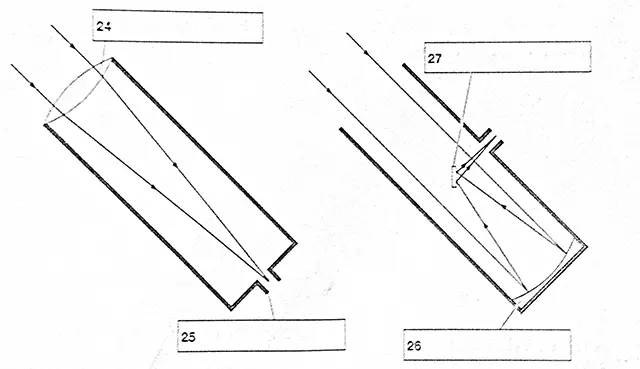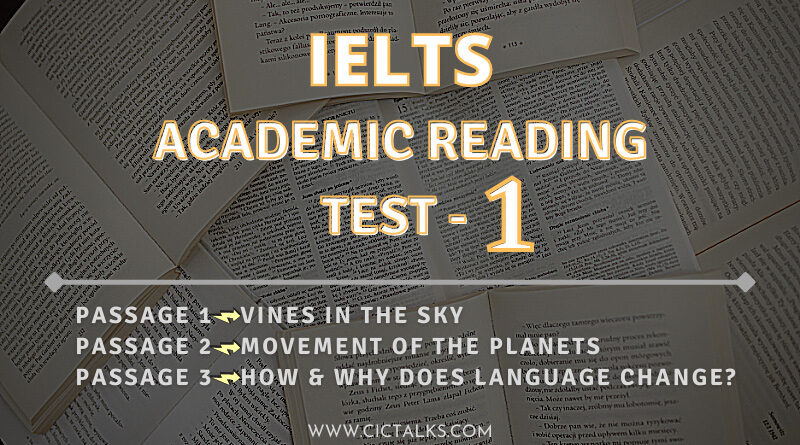IELTS Academic Reading Practice TEST – 1
IELTS Reading Practice Test 2022: FREE Reading practice test prepared by our experts to help you quickly reach band 8+ scores.
There are 03 reading passages between 600 – 900 words each. Candidates are required to find information and mark their answers on the answer sheet (download link below).
Total no. of questions : 40
Time allowed : 1 hour

Passage 1
You should spend about 20 mins on questions 1-13.
| VINES IN THE SKY A. The future farms may be built right in the middle of your neighbourhood. Suburban sprawl, combined with huge economies of scale in agricultural operations, have driven food production away from centres of population, with an increase in travel cost and risk of spoilage en route. However, the days of market gardens in cities supplying fresh food items may soon be over; mass urban farming may soon replace them. A visionary microbiologist, David Michael from U of T , sees our future cities filled with a new kind of market garden. The creator of this radical ‘vertical farming’ thought describes the evolution of concept from older idea of ‘rooftop gardening’ in Manhattan. While this was amazing, it couldn’t be made sustainable on a mass scale. But it planted the seed of another great idea. Looking at greenhouse development projects in New York, the resulting concept was mass-scale, indoor, urban farming in sky scrappers. B. Following this, David set up lab projects aimed at different design challenges and attracted a huge range of enthusiastic collaborators and contributors. He believes this vertical farming method possess solutions to some of the world’s critical issues. The world population is expected to grow by 3.5 billion to 8.6 billion over the next half century. By then, some 80% will live in the cities, and they will need something to eat. At the same time, conventional agriculture and grazing land takes up an enormous amount of space, with over 1/3rd of the world’s surface currently used for farming. David figures that in the next 5 decades an area new arable land of roughly the size equivalent to Brazil will be required to feed the world’s growing population – land that simply non existent. C. David’s concept relies on using green architecture methods and materials to build sky scrappers that grow and produce agricultural crops. New technologies like cheaper reflectors, which reflect sunlight where it’s required, more efficient energy solar panels and system-wide recycling are central to the plan. One usual feature is the use of a type of shellfish for the filteration of water. These can clean urban waste to a state more suitable for irrigation. D. ‘Outside, one acre of land means single crop per year,’ says David. ‘Indoors, you can cultivate single crop every three months. You can get four different crops per year.’ He suggests that 150 such buildings could feed the entire neighbourhood of New York for one year. Indoor crops require less pesticides and are less vulnerable to natural problems, such as famine. Some academics say that a single sky scrapper farm covering 1.5 hectares could produce enough food to feed 35,000 people for one year – the same as 450 hectare farm. Each floor would be rigged up with with special hydroponic watering systems, solar panels to provide electricity and artificial lighting. However, vertical farming is not without difficulties. One is – artificial lighting uses a great amount of electricity and generate considerable amount of heat as well. Another is cost, with some $95 million per building for construction and another $5 million for operation per year. E. Among experts, opinions vary on the success of this project. It is a serious challenge to create conditions suitable for growth, and some even think the yield from crop would not be economically viable. ‘My biggest reservation is that the basic premise has flaws. We already know the ways to increase food production from existing land resources, particularly in areas with surplus land area for instance, sub-Saharan Africa. It’s just that we do it incredibly wrong at the moment, says Rob Sinha, a rural development researcher at the University of Whales. ‘This is a rich person’s aspiration.’ F. Yet there are strong supporters everywhere. Luc Jarvis, an advocate at Canda’s IDRC, says the vertical farm is not only possible, but will happen very soon. ‘It would gather at one site different elements already at work around the world, he says. David has the backing of his University as well as venture capitalists from China, India, Middle East and Netherlands. If the vertical farming vision becomes a reality, we could expect fresh fruits and veggies sourced from just around the corner, except these might come from the 51st floor. |
Question 1-6
Which section contains the information given below ?
Write the correct letter, A-F, you may use any letter more than once.
1. Doubts about the feasibility and viability of the project – ………………
2. The idea of shifting market gardens from the outskirts to inner-city circles – ………………
3. How the system would avoid existing agricultural problems – ………………
4. A previous program that was impractical for widespread usage – ………………
5. Sources of financial support to the proposal – ………………
6. A method of dealing with waste substance – ………………
Question 7-10
Choose NO MORE THAN THREE WORDS AND/OR A NUMBER from the passage for each answer.
7. Population within 50 years thought to reach ………………
8. Population within 50 years ……………… living in rural areas
9. Proportion of earth now used for farming ………………
10. We will need an extra area as large as ……………… to provide food
Questions 11-13
Choose NO MORE THAN THREE WORDS from the passage.
11. How will the indoor farms generate energy ? ………………
12. Besides the expense, what is the other challenge for indoor farms ? ………………
13. When does Luc Jarvis believe that David’s idea become a reality ? ………………
Passage 2
| MOVEMENTS OF THE PLANETS People have pondered the movements of planets and stars for as long as life of humans on earth. Long ago it was noticed that some lights in the sky looked permanent in relation to each other and these were called ‘Fixed stars’, whereas other lights moved about much more independently and were called ‘Wanderers’. We know the latter as planets and we also know that stars are not fixed in fact move in predictable manner. That both stars and planets circled the sky over 24 hours was supposed to be because they revolved around the earth. One early theory explained the ‘music of spheres’. It was believed that the stars/planets were fixed on the glass like spheres that were centred on the earth and created high-pitched music as they moved, this latter belief originated from humming in the ears at high altitudes. The Greek astronomer, Ptolemy was the first to suggest a pattern to these movements and in his Ptolemaic system the Sun, Moon and the Planets each had a sphere moving freely from others, and the stars were all fixed on the outer sphere. The system was thus able to account for the differing movements then witnessed. By the 16th century, more accurately measuring instruments were available, even before Telescope was developed. Nicolas, a Polish monk, spent his life making accurate observation of heavens. He tried to explain the logic behind the movement of planets but found that the circular movement of a sphere could not explain why, for instance, Mars stopped apparently and gone backwards for a while. He discovered that the planets move far more predictably, and circle the Sun rather than the Earth. Now the problem is that, many people believed man was the epicentre of the universe, and so not everyone accepted it. Copernicus avoided this problem by suggesting the theory as a method of accurately finding dates of important festivals. The theory was widely supported in the 17th century, when Galileo taught Copernican system to his students. The telescope was invented in the Netherlands to accurately measure planetary motion. The German astronomer, Johan Kepler used it to discover that the Copernican observations were inaccurate and so could not predict the planet orbits. Copernicus assumed that the planets had circular movements around the Sun, but Kepler found they didn’t, in fact they moved in ellipses. He then developed his three laws of planetary motion. Tycho Brahe, Danish astronomer had been appointed as the court astronomer to the Romans and had made important observations that Kepler needed for his theories. However, although Kepler already had three laws explaining the movement of planets, Isaac Newton explained WHY they move in 18th century. Isaac’s invention of reflecting telescope is often seen as a defining moment in astronomical discoveries, but in fact he only enhanced it; the original telescope was invented by Lippershey in 1608. He used convex lens in a tube, focusing light into an eyepiece. The first telescopes were seen as vital military instrument to detect the distant approach of the enemy before Galileo used one to see night sky. Newton discovered that a concave mirror reflecting light onto a flat mirror gave an accurately enhanced image of the heavens. Furthermore, mirrors were easier to produce than lenses and could be made larger, thus increasing the ability of astronomers to trace the star movements. Yet it was Newton’s laws of gravitation that explained the the accurate movement of planets. |
Questions 14-19
Match each statement with the correct persons, A-E. You may use any letter more than once.
A. Ptolemy B. Nicolaus Copernicus C. Galileo Galilei D. John Kepler E. Isaac Newton
14. A change in the design led to an improvement in scientific instrument – …………………..
15. The planets took an egg-shaped trajectory – …………………..
16. The science at the time did not agree with what was observed in the sky – …………………..
17. The planets revolved around a different object in contrast to what was believed earlier – …………………..
18. A revolutionary theory provided reasons for the pattern in which the planets moved – …………………..
19. The use of a telescope provided evidence that amended the earlier observations – …………………..
Questions 20-23
Choose NO MORE THAN THREE WORDS from the paragraph.
20. Early observers used the terminology ………………….. to refer to motionless features in the sky.
21. Objects that appeared to be mobile are now called as …………………..
22. According to an early thinking, ………………….. was made by the motion of celestial bodies.
23. Ptolemy believed that every planet moved within its own …………………..
Questions 24-27
The diagrams show the basic differences between Lippershey’s and Newton’s telescopic designs.
Label the diagrams below.
Choose NO MORE THAN THREE WORDS from the passage.

Passage 3
| HOW AND WHY DOES LANGUAGE CHANGE ? During the 19th century, it was believed that a sound change affected the whole language at the same time: one sound system smoothly develop into the second, and all words that contained a particular sound would be affected in the same manner. We now know that such a change does not operate in an ordinary manner. Some speakers introduce the change into their speech before others do; some use it more often than others. A more accurate way is to think change as something gradually spreading through the words of a language. At first just a few people use the change occasionally in common language; then a large number of words are affected, with the sound gradually used consistently; then the majority of words counter the change. The evidence of this kind of process originated from sociolinguistic studies of the variations in modern languages. These studies move forward on the assumption that language variation is an evidence of the change in progress of a language. Detailed observations are made of the way in which different people speak in different social circumstances. The parameters that demonstrate these differences are called as Linguistic Variables. These are small scale studies, but they have large implications. The same gradual process of change affects whole language as well as whole dialects. The metaphor of a wave has proved to be attractive since the 19th century: a change spreads through a language is just like a stone sends ripples across a pool. It is easy to recognise a change in a language – but only after the change has taken place. It is not so difficult to think on how people spoke several years ago to point to a new word recently entered the language. But, it is impossible to predict which sounds, words or grammatical construction will change in the next twenty years. It is also difficult to precisely say about the origins of a change in a language. Who first used ? where it was used ? and when exactly it was used ? Historical dictionaries shows an approximate date of entry for a new word or meaning – but these dates invariably reflect the earliest known use of that word in written form. The first usage of the word in speech is an unknown number of years previous to that. To obtain answers to these questions, we need to know more about why language transform. With the causes of change, we could start to make predictions about when a change was more likely to take place, and observe it while it was happening. There has long been thoughtful speculation on the matter, with suggested causes coming out from the fields such as theology and climatology (which is a result of human physical location – the mountain dweller having a physiologically different speech capacity compared with the valley dweller). Some scholars have adopted a highly negative view, believing that the causes can never be found. These days, the speculation and pessimism are being replaced by an increasing amount of scientific studies, which has shown that there is no one reason for language change. Several factors play their role, some with the nature of society, and some with the nature of language structure. When humans move away from each other, their language will diverge. The two groups will have variety of experiences, and at the very least their vocabulary will change. Similarly, when people come into contact, their language will converge. The sounds, grammar and vocabulary of one group are likely to put some influence on the other. These days, the increased mobility of people between countries, makes this a major factor. New ideas are being created constantly, and language changes to accept them. At the same time, old objects and ideas become obsolete. Some change is the result of one population group imperfectly learning the language of another. This is a common illustration of bilingualism. The minority language forms a small category of people that in the long term influences major category. People usually talk like those they admire – a process that may be conscious or subconscious. Conscious change can be observed in those cases where people use or avoid certain features of their spoken language – such as happened with the English pronoun “whom”. Subconscious change, where people don’t know the direction in which their speech is moving; it is less noticeable. The movement may be towards a favoured dialect, or away from one that is held in low esteem. The speakers are mostly aware of the existence of linguistic differences, but unaware of any trend in their own speech connected to their attitude. |
Questions 28-34
Choose the correct letter – A,B,C or D
28. What are linguistic variables ?
A. how different people use different language
B. they show unpredictability of changes in languages
C. they record laws of speaking
D. they show who introduce linguistic change
29. According to author, what is the relationship between changes in languages and in dialects ?
A. a small change in dialect will signal major change in a language
B. language change is closely followed by dialect change
C. they start rapidly then slow down gradually
D. none of them happen suddenly
30. When does the general language change can be recognised ?
A. when vocabulary first get into a language
B. after a decade of usage
C. when majority people in a group have changed their way of speaking
D. only follows the occurrence of a change
31. Why location influence change in language ?
A. people from warmer places are more creative
B. different environments affects human bodies
C. people living in hills use different expressions than others
D. speed of language change affected by the altitude
32. What has been demonstrated by recent scientific research ?
A. new language patterns are dictated by influential people
B. different relationships among people slow down language change
C. language change has more than one cause
33. How language change seem to be affected by human mobility ?
A. it increases the rate at which new languages are learnt
B. people who travel struggle to adopt a new language
C. language changes when people leave other members of their group
D. it has no affect on the language change
34. Most often found aspect of language change is ?
A. changes that user himself does not notice
B. deliberately imitate someone to achieve status
C. newcomers attempt to improve pronunciation
D. efforts to update vocabulary
Questions 35-40
Do the following statements agree with the claims of the writer in Reading Passage 3 ?
YES – write if statement agrees
NO – write if statement contradicts
NOT GIVEN – write if no information provided
35. Linguistic change occurs when a new pronunciation is uniformly adopted ………………….
36. Water patterns are too even to be compared to the language patterns ………………….
37. Historical dictionaries registered the first spoken use of a new word ………………….
38. Recently, new vocabulary has mainly been introduced electronically ………………….
39. Change can happen when new speakers of a language make errors ………………….
40. An established language can get influenced by an introduced language ………………….



